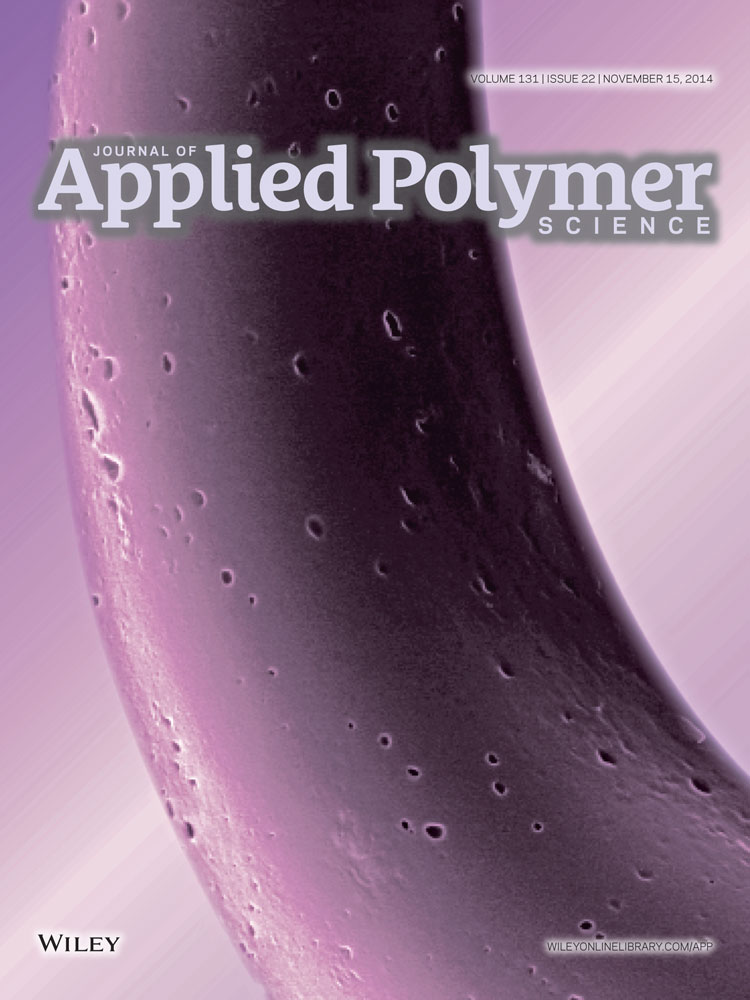Textile-surface interfacial asymmetric polymerization
Corresponding Author
Hiromasa Goto
Division of Materials Science, Faculty of Pure and Applied Sciences, University of Tsukuba, Tsukuba, Ibaraki, 305–8573 Japan
Correspondence to: H. Goto (E-mail: [email protected])Search for more papers by this authorJinmi Jwa
Division of Materials Science, Faculty of Pure and Applied Sciences, University of Tsukuba, Tsukuba, Ibaraki, 305–8573 Japan
Search for more papers by this authorKuniharu Nakajima
Division of Materials Science, Faculty of Pure and Applied Sciences, University of Tsukuba, Tsukuba, Ibaraki, 305–8573 Japan
Search for more papers by this authorAohan Wang
Division of Materials Science, Faculty of Pure and Applied Sciences, University of Tsukuba, Tsukuba, Ibaraki, 305–8573 Japan
Search for more papers by this authorCorresponding Author
Hiromasa Goto
Division of Materials Science, Faculty of Pure and Applied Sciences, University of Tsukuba, Tsukuba, Ibaraki, 305–8573 Japan
Correspondence to: H. Goto (E-mail: [email protected])Search for more papers by this authorJinmi Jwa
Division of Materials Science, Faculty of Pure and Applied Sciences, University of Tsukuba, Tsukuba, Ibaraki, 305–8573 Japan
Search for more papers by this authorKuniharu Nakajima
Division of Materials Science, Faculty of Pure and Applied Sciences, University of Tsukuba, Tsukuba, Ibaraki, 305–8573 Japan
Search for more papers by this authorAohan Wang
Division of Materials Science, Faculty of Pure and Applied Sciences, University of Tsukuba, Tsukuba, Ibaraki, 305–8573 Japan
Search for more papers by this authorABSTRACT
This research demonstrated that polymerization of aniline on cellulose produces chiroptically active composites. Polymerization of aniline in the presence of cotton fibers consisting of chiral cellulose are performed to prepare a polyaniline (PANI)/cotton composite. The polymerization is conducted at the cotton interface. The resultant PANI/cotton composite shows chiroptical activity elucidated with diffuse reflectance circular dichroism. In this reaction, textile-surface interfacial asymmetric polymerization is performed with imprinting of chiral structure from the cotton as a natural chiroptically active polymer to the PANI. © 2014 Wiley Periodicals, Inc. J. Appl. Polym. Sci. 2014, 131, 41118.
Supporting Information
Additional Supporting Information may be found in the online version of this article.
| Filename | Description |
|---|---|
| app41118-sup-0001-suppinfo01.pdf206.9 KB |
Supplementary Information |
Please note: The publisher is not responsible for the content or functionality of any supporting information supplied by the authors. Any queries (other than missing content) should be directed to the corresponding author for the article.
REFERENCES
- 1 Wu, Y.; Mao, X.; Ma, X.; Huang, X.; Cheng, Y.; Zhu, C. Macromol. Chem. Phys. 2012, 213, 2238.
- 2 Langeveld-Voss, B. M. W.; Janssen, R. A. J.; Christiaans, M. P. T.; Meskers S. C. J.; Dekkers, H. P. J. M.; Meijer, E. W. J. Am. Chem. Soc. 1996, 118, 4908.
- 3 Aoki, T.; Kaneko, T.; Maruyama, N.; Sumi, A.; Takahashi, M.; Sato, T.; Teraguchi, M. J. Am. Chem. Soc. 2003, 125, 6346.
- 4 Shah, P. N.; Min, J.; Kim, H.-J.; Park, S.-Y.; Lee, J.-S. Macromolecules 2011, 44, 7917.
- 5 Nath, G. Y.; Samal, S.; Park, S.-Y.; Murthy, C. N.; Lee, J.-S. Macromolecules 2006, 39, 5965.
- 6 Majidi, M. R.; Kane-Maguire, L. A. P.; Wallace, G. G. Polymer 1994, 35, 3113.
- 7 Goto, H.; Ohta, R. Macromol. Chem. Phys. 2010, 211, 2071.
- 8 Wang, J.; Zhang, K.; Zhao, L.; Ma, W.; Liu, T. Synth. Met. 2014, 188, 6.
- 9 Savith, K. U.; Prabu, H. G. J. Appl. Polym. Sci. 2013, 127, 3147.
- 10 Arsalani, N.; Hayatifar, M. J. Appl. Polym. Sci. 2004, 93, 2528.
- 11 Eftekhari, A.; Yazdani, B. J. Appl. Polym. Sci. 2011, 122, 1579.
- 12 Shinde, S. D.; Jayakannan, M. J. Appl. Polym. Sci. 2013, 127, 1781.
- 13 Silveira, F. Z.; Duarte, G. W.; Tachinski, C. G.; Piletti, R.; Fiori, Jr., J.; Peterson, M.; Riella, H. G.; Fiori, M. A. J. Appl. Polym. Sci. 2013, 128, 430.
- 14
Volokhina, A.V. Fibre Chem. 1994, 26, 9.
10.1007/BF00545520 Google Scholar
- 15 Goto, H. Text. Res. J. 2011, 8, 122.
- 16 Andreatta, A.; Cao, Y.; Chiang, J. C.; Heeger, A. J.; Smith, P. Synth. Met. 1988, 26, 383.
- 17 Goto, H. Macromolecules 2007, 40, 1377.
- 18 Goto, H. Phys. Rev. Lett. 2007, 98, 253901.
- 19 Goto, H.; Miyazawa, T.; Tomishige, K.; Kunimori, K.; Kiebooms, R. H. L.; Akiyama, Y.; Akagi, K. J. Appl. Polym. Sci. 2008, 107, 438.
- 20 Kawagoe, Y.; Fujiki, M.; Nakano, Y. New J. Chem. 2010, 34, 637.
- 21 Wulff, G.; Sarhan, A.; Zabrocki, K. Tetrahedron Lett. 1973, 4329.
- 22 Wulff, G. Angew. Chem. Int. Ed. Engl. 1995, 34, 1812.
- 23 Gamble, G. R. J. Agric. Food. Chem. 2003, 51, 7995.
- 24 Krakhmalev, V. A.; Paiziev, A. A. Cellulose 2006, 13, 45.
- 25 Ceylan, O.; Landuyt, L. V.; Meulewaeter, F.; Clerck, K. D. Cellulose 2012, 19, 1517.
- 26 Abe, K.; Iwamoto, S.; Yano, H. Biomacromolecules 2007, 8, 3276.
- 27 Nogi, M.; Iwamoto, S.; Norio, A. N.; Yano, H. Adv. Mater. 2009, 21, 1595.
- 28 Mattana, G.; Cosseddu, P.; Fraboni, B.; Malliaras, G. G.; Hinestroza, J.P.; Bonfiglio, A. Org. Electron. 2011, 12, 2033.
- 29
Zakirov, A. S.;
Yuldashev, S. U.;
Cho, H. D.;
Lee, J. C.;
Kang, T. W.;
Mamadalimov, A. T. J. Appl. Phys. 2011, 110, 114522.
10.1063/1.3668118 Google Scholar
Citing Literature
November 15, 2014




